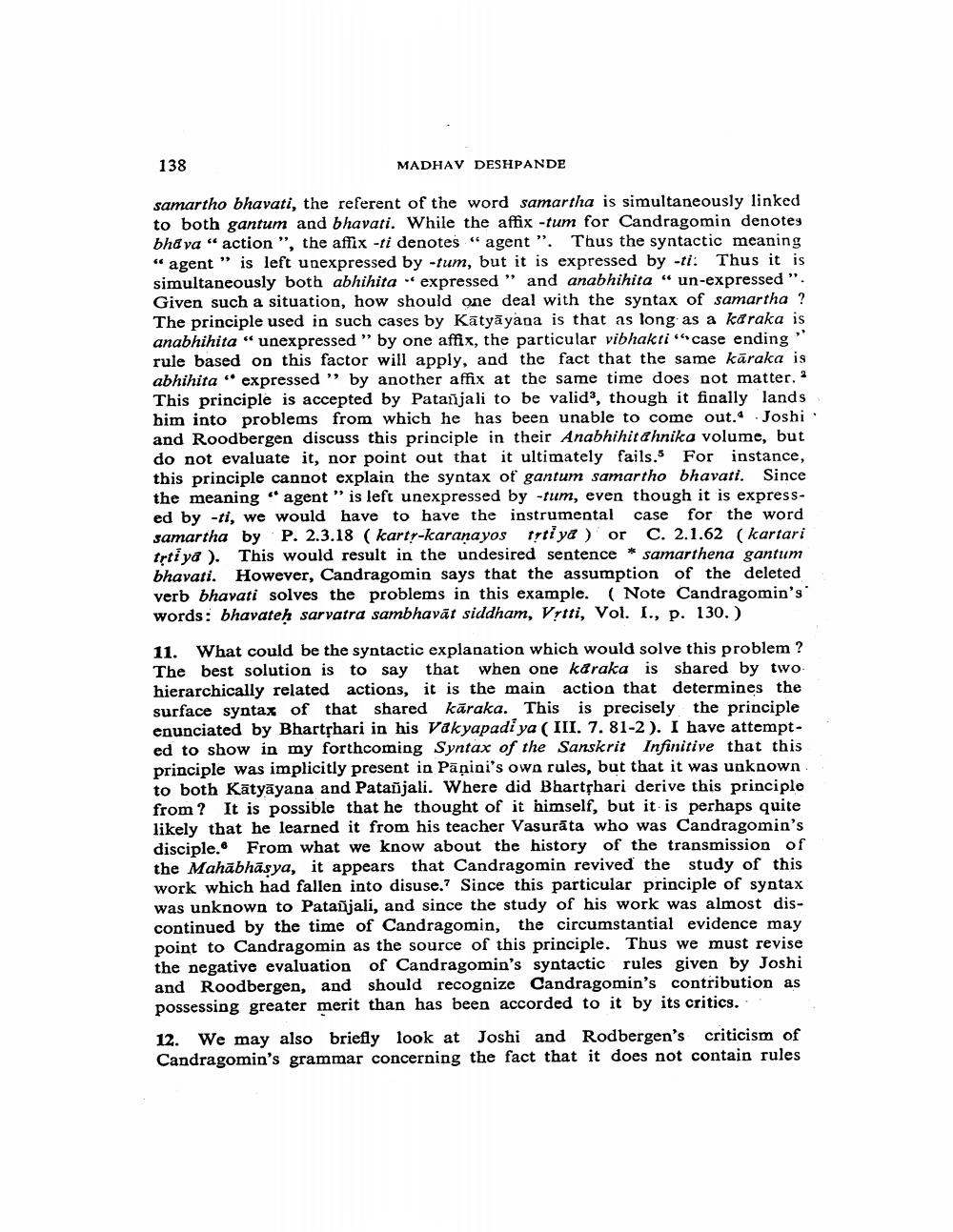Book Title: Candragomins Syntactic Rules Some Misconceptions Author(s): Mahadev Deshpande Publisher: Mahadev Deshpande View full book textPage 6
________________ 138 MADHAV DESHPANDE samartho bhavati, the referent of the word samartha is simultaneously linked to both gantum and bhavati. While the affix -tum for Candragomin denotes bhava "action", the affix -ti denotes "agent". Thus the syntactic meaning 66 agent " is left unexpressed by -tum, but it is expressed by -ti: Thus it is simultaneously both abhihita "expressed" and anabhihita "un-expressed". Given such a situation, how should one deal with the syntax of samartha ? The principle used in such cases by Katyayana is that as long as a karaka is anabhihita "unexpressed" by one affix, the particular vibhakti "case ending " rule based on this factor will apply, and the fact that the same karaka is abhihita" expressed" by another affix at the same time does not matter. 2 This principle is accepted by Patanjali to be valid3, though it finally lands him into problems from which he has been unable to come out. Joshi and Roodbergen discuss this principle in their Anabhihitahnika volume, but do not evaluate it, nor point out that it ultimately fails. For instance, this principle cannot explain the syntax of gantum samartho bhavati. Since the meaning "agent" is left unexpressed by -tum, even though it is expressed by -ti, we would have to have the instrumental case for the word samartha by P. 2.3.18 (karty-karanayos tṛtiya) or C. 2.1.62 (kartari trtiya). This would result in the undesired sentence * samarthena gantum bhavati. However, Candragomin says that the assumption of the deleted verb bhavati solves the problems in this example. (Note Candragomin's words: bhavateḥ sarvatra sambhavat siddham, Vrtti, Vol. I., p. 130.) 11. What could be the syntactic explanation which would solve this problem? The best solution is to say that when one karaka is shared by two hierarchically related actions, it is the main action that determines the surface syntax of that shared karaka. This is precisely the principle enunciated by Bhartṛhari in his Vakyapadi ya (III. 7. 81-2). I have attempted to show in my forthcoming Syntax of the Sanskrit Infinitive that this principle was implicitly present in Panini's own rules, but that it was unknown to both Katyayana and Patanjali. Where did Bhartṛhari derive this principle from? It is possible that he thought of it himself, but it is perhaps quite likely that he learned it from his teacher Vasurata who was Candragomin's disciple. From what we know about the history of the transmission of the Mahabhāṣya, it appears that Candragomin revived the study of this work which had fallen into disuse." Since this particular principle of syntax was unknown to Patanjali, and since the study of his work was almost discontinued by the time of Candragomin, the circumstantial evidence may point to Candragomin as the source of this principle. Thus we must revise the negative evaluation of Candragomin's syntactic rules given by Joshi and Roodbergen, and should recognize Candragomin's contribution as possessing greater merit than has been accorded to it by its critics. 12. We may also briefly look at Joshi and Rodbergen's criticism of Candragomin's grammar concerning the fact that it does not contain rulesPage Navigation
1 ... 4 5 6 7 8 9 10 11 12 13
